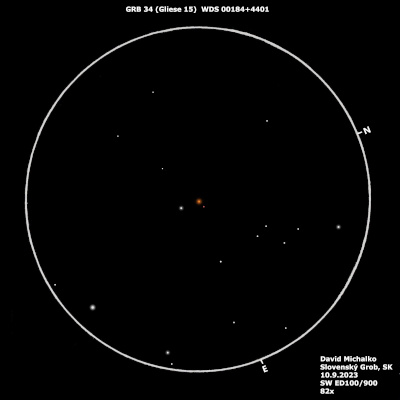And
☀8.31/11.36mag
Ø
34''

GRB 34 (Gliese 15) is a binary system located 11.7 light-years away from the Sun. The primary component is a red dwarf of spectral class M1V with a mass of approximately 0.38 and a radius of 0.386 times that of the Sun. Its companion is also a red dwarf of spectral class M3.5V with a mass of 0.15 and a radius of 0.18 times that of the Sun, orbiting the primary component at a distance of 147 AU once every 2600 years. Both components are eruptive stars with irregular brightness variations. In 2014, an exoplanet was discovered orbiting the primary component at a distance of 0.072 AU. It is likely a rocky Super-Earth with a mass of 3.03 Earths and an orbital period of 11.4 days. The estimated temperature on the planet is around 276°C, making it "a bit warmer" than on Earth. Another exoplanet was discovered in 2018 at a distance of approximately 5.4 AU from the parent star. It is a Neptune-like planet with a mass of 36 Earths and an orbital period of 20.8 years. Since the habitable zone of the star GRB 34A is between 0.112 AU and 0.239 AU, life as we know it is not possible on either of these planets. GRB 34A is expected to be the fourth closest planetary system.
100mm - GRB 34 is located about 5° northwest of M31 - the Andromeda Galaxy. It is a relatively easily observable binary star. In 100mm, I observed both components at about 82x magnification, but even lower magnification would likely suffice. The main component appeared orange, and the faint companion appeared dark burgundy.